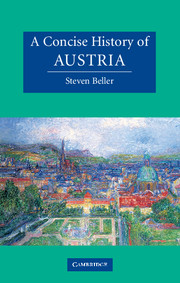Book contents
- Frontmatter
- Contents
- List of illustrations
- List of maps
- Acknowledgements
- Map 1 The Austrian Republic, 2006
- Introduction
- 1 The Eastern March, to 1439
- 2 AEIOU, 1439–1740
- 3 Countering reform, 1740–1866
- 4 Empire on notice, 1866–1918
- 5 The land without qualities, 1918–1945
- 6 Austria Inc., from 1945
- Conclusion
- Guide to further reading
- Index
- CAMBRIDGE CONCISE HISTORIES
4 - Empire on notice, 1866–1918
Published online by Cambridge University Press: 05 June 2014
- Frontmatter
- Contents
- List of illustrations
- List of maps
- Acknowledgements
- Map 1 The Austrian Republic, 2006
- Introduction
- 1 The Eastern March, to 1439
- 2 AEIOU, 1439–1740
- 3 Countering reform, 1740–1866
- 4 Empire on notice, 1866–1918
- 5 The land without qualities, 1918–1945
- 6 Austria Inc., from 1945
- Conclusion
- Guide to further reading
- Index
- CAMBRIDGE CONCISE HISTORIES
Summary
After Königgrätz there remained a large Habsburg Monarchy, which soon became the Dual Monarchy of Austria-Hungary; just over fifty years later this disappeared, torn apart to create an apparently neat pattern of nation-states across the face of East Central Europe. The last half-century of the Monarchy has usually been seen as the inevitable decline and fall of a dynastic supra-national state unable to resist the tide of nationalism. Even at the time, the very impermanence of the Compromise of 1867, with its renegotiable clauses, strengthened the impression of the Monarchy as an ‘empire on notice’.
Subsequent Austrian history is unthinkable without the experience of imperial collapse, but historians have recently begun emphasizing the staying power of the Monarchy, that its destruction after 1914 was not a tragic inevitability but rather prematurely ended a viable, even flourishing polity, and there were indeed positive aspects to this last phase. There were greater transformations – economic, technological, social, political, cultural and intellectual – in the Monarchy during these last decades than at any other time in its history.
Yet the Monarchy's modernization was particularly contested and problematic. Some societies are more adaptable to modernization than others, and the presence of pre-modern elements of a common identity greatly facilitated the emergence of modern nation-states; not so the Habsburg Monarchy. The agrarian and traditional sectors proved more powerful and intractable than in other societies; and the Monarchy's ethnic diversity vastly complicated attempts to provide a sense of common endeavour.
- Type
- Chapter
- Information
- A Concise History of Austria , pp. 141 - 196Publisher: Cambridge University PressPrint publication year: 2007



